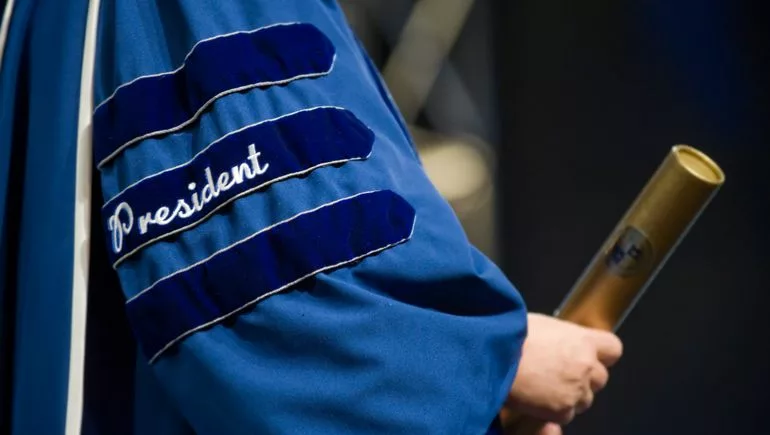[ad_1]
Dive Brief:
- The share of women in college presidencies hasn’t budged much in years, with just over 3 in 10 seats currently held by women, according to the American Council on Education’s latest survey of chief executives released Friday.
- In 2022, roughly 33% of college presidents at all levels were women. That’s only about a 3 percentage point increase from 2016, the last time ACE conducted the American College President Study. The remaining 67% of survey respondents last year were men. None said they were nonbinary.
- Presidencies are, however, steadily — if not dramatically — becoming more racially diverse. Nearly 73% of presidents identified as White in 2022, down from 83% in 2016.
Dive Insight:
Women have historically been relegated to leadership roles at women’s colleges and just a few coeducational institutions, according to ACE.
Despite initiatives to bring more gender diversity to the profession, stubborn gaps persist, as they have since the onset of ACE’s study in 1986. At that time, only about 10% of college presidents were women.
While that share has inched up over decades, still the “gap feels particularly large” when women made up nearly 60% of undergraduates in fall 2020, ACE’s report said.
ACE has set a goal of achieving gender parity among higher ed executives by 2030 through its “Moving the Needle” program, which asks leaders to pledge to advance women in these positions.
Initiatives like this span the country, and the data in ACE’s report shows they are succeeding to a degree, said Kenya Ayers-Palmore, president of Tarrant County College Northeast, in Texas.
Ayers-Palmore spoke at a session at ACE’s annual meeting Friday. She said higher education often thinks of itself as monolithic. But to rectify gender gaps, different types of institutions should talk with each other about what works, she said.
Pamela Eddy, associate provost for faculty affairs and development at William & Mary, in Virginia, said at the same session that it’s important to bring resources “to the ground,” particularly for colleges in rural areas.
Some women leaders are unaware of national resources for bolstering women leaders, Eddy said.
While far fewer women than men fill college presidencies, the data looks even worse for women who are Black or Hispanic.
Almost 70% of women presidents last year were White. Only 14% of women presidents identified as Black or African American, while about 8% identified as Hispanic or Latina.
ACE said it could not even highlight conclusions about women presidents of other races, like Asian American and American Indian, due to their smaller sample sizes.
White women presidents made up roughly 27% of the 1,075 chief executives responding to the survey.
Eddy said diversifying the presidencies can start with diversifying faculty bodies, which often serve as a pipeline to leadership positions.
Women were also more likely to be in presidencies at associate degree-granting institutions, like community colleges, rather than the more prominent and generally wealthier doctoral colleges. Nearly 71% of doctoral college presidents were men in 2022, a little higher than the overall share of men college presidents. Nearly 44% of women presidents, meanwhile, led associate degree colleges.
The profession saw some new racial diversity. The share of Black or African American presidents almost doubled from the previous survey, climbing to about 14%. And the share of Hispanic or Latino presidents reached almost 6%, from about 4% in 2016.
Of particular concern, too, is the slowly shortening average tenure of presidents. Executives reported staying in their jobs for 5.9 years, falling from 6.5 years in 2016.
About 55% of presidents also said they intended to leave their job within the next five years. Just over 11% said they’d still be in their current role a decade or more from now. Those who plan to leave in the next three to five years have been on the job an average 6.7 years.
[ad_2]
Source link
Meet Our Successful Graduates: Learn how our courses have propelled graduates into rewarding
careers. Explore their success stories here!
Discover More About Your Future: Interested in advancing your teaching career? Explore our
IPGCE, MA, and QTS courses today!

Explore Our Courses: Ready to take the next
step in your education journey? View our
comprehensive course offerings now!

